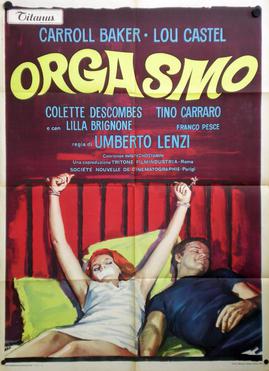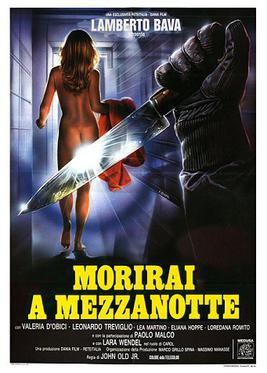
Orgasmo is a 1969 giallo film co-written and directed by Umberto Lenzi and starring Carroll Baker, Lou Castel, and Colette Descombes. It follows a wealthy American socialite who finds herself preyed upon by two nefarious young siblings who indulge her in sex, drugs, and alcohol while she vacations at an Italian villa. This film helped launch the second phase of Baker's career, during which she became a regular star in Italian productions.

In Italian cinema, giallo is a genre of murder mystery fiction that often contains slasher, thriller, psychological horror, psychological thriller, sexploitation, and, less frequently, supernatural horror elements.

Lamberto Bava is an Italian film director. Born in Rome, Bava began working as an assistant director for his director father Mario Bava. Lamberto co-directed the 1979 television film La Venere d'Ille with his father and in 1980 directed his first solo feature film Macabre.
Ernesto Gastaldi is an Italian screenwriter. Film historian and critic Tim Lucas described Gastaldi as the first Italian screenwriter to specialize in horror and thriller films. Gastaldi worked within several popular genres including pepla, Western and spy films.
Bruno Mattei was an Italian film director, screenwriter, and editor who directed exploitation films in many genres, including women in prison, nunsploitation, zombie, mondo, cannibal, and Nazisploitation films. Mattei's films often followed popular genre trends of the era. Mattei continued work as a director primarily in the Philippines until his death in 2007, just before he was to enter production on his fifth Zombie film.
Franco Ferrini is an Italian screenwriter. His works often fall into the genres of horror or thriller. He was one of the interviewees represented in the book Spaghetti Nightmares.
Door into Darkness is an Italian television series conceived by Dario Argento. It consists of four one-hour episodes broadcast in 1973.
Alberto De Martino was an Italian film director and screenwriter. Born in Rome, De Martino started as a child actor and later returned to the cinema where worked as a screenwriter, director and dubbing supervisor. De Martino's films as a director specialised in well-crafted knock-offs of Hollywood hit films. These films were specifically created films in Western, horror and mythology genres which were developed for the international market. The Telegraph stated that his best known of these film was probably The Antichrist. The Antichrist capitalized on the box-office appeal of The Exorcist (1973) and in its first week in the United States earned a greater box office than Jaws.

Delirium is a 1987 Italian giallo film directed by Lamberto Bava and starring Serena Grandi, David Brandon, George Eastman and Daria Nicolodi. The film is about Gioia, the owner of the adult Pussycat magazine. She is harassed by a killer who sends her photos of her co-workers with her own erotic photography in the background.

Cold Eyes of Fear is a 1971 Italian-Spanish thriller film directed by Enzo G. Castellari, starring Fernando Rey.

Col cuore in gola is a 1967 giallo film directed by Tinto Brass. It is loosely based on the novel Il sepolcro di carta written by Sergio Donati. The film used storyboards from cartoonist Guido Crepax. It has been released under several titles including Deadly Sweet and I Am What I Am.

The Killer Is on the Phone is a 1972 giallo film directed by Alberto De Martino. It was released in the U.S. in July, 1975. The film is set in Bruges, Belgium, and stars Telly Savalas and Anne Heywood. The story follows an attractive actress who suffers from amnesia and paranoia triggered by a chance encounter with a professional assassin, who in turn begins to follow her with his knife.

Amuck! is a 1972 Italian giallo film written and directed by Silvio Amadio.

Sweets from a Stranger is a 1987 Italian thriller film directed and co-written by Franco Ferrini. The film is about a serial killer targeting sex workers. The women decided to band together to protect themselves, but their efforts are only partially successful as the killer continues their killing spree. As the police investigate, the sex workers group together to try and find some leads on their own.

So Sweet... So Perverse is a 1969 giallo film directed by Umberto Lenzi and written by Ernesto Gastaldi, starring Carroll Baker and Jean-Louis Trintignant. Set in Paris, it tells the story of a wife who plots to get rid of a rich and errant husband but is herself the victim of her accomplices.

The House of the Yellow Carpet is a 1983 Italian giallo film directed by Carlo Lizzani.

Formula for a Murder is a 1985 Italian giallo film co-written and directed by Alberto De Martino.

Midnight Killer is a 1986 Italian giallo film starring Valeria D'Obici and Leonardo Treviglio, and directed by Lamberto Bava.
Ermanno Donati was an Italian film producer. Along with Luigi Carpentieri, Donati won the Nastro d'Argento award for Best Producer for the film The Day of the Owl.
Madness is a 1994 Italian giallo film directed by Bruno Mattei. The film is about Giovanna Dei who is the creator of the comic series Doctor Dark, a character with a split personality. After a series of murders begin to happen in a similar fashion to how Doctor Dark's fictional murders. Dei defends herself against any criticism of the violence in her comics and later finds that the murderer is leaving the eyeballs of her victims in her apartment.













